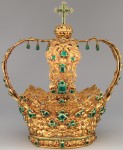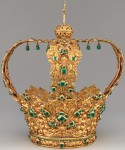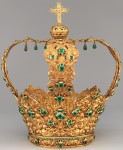 The Crown of the Andes, a rare surviving example of 17th and 18th century colonial Spanish gold work, the oldest and largest collection of emeralds in the world and the oldest surviving emerald and gold crown or tiara, has been acquired by the Metropolitan Museum of Art in New York City. Famous and coveted for at least three centuries, the crown has been in private hands since 1936. It has gone on display at special events like the Great Lakes Exposition in Cleveland, Ohio, in 1937, the 1939 New York World’s Fair, the 1957 American Gem Society convention in Philadelphia and most recently, at the
The Crown of the Andes, a rare surviving example of 17th and 18th century colonial Spanish gold work, the oldest and largest collection of emeralds in the world and the oldest surviving emerald and gold crown or tiara, has been acquired by the Metropolitan Museum of Art in New York City. Famous and coveted for at least three centuries, the crown has been in private hands since 1936. It has gone on display at special events like the Great Lakes Exposition in Cleveland, Ohio, in 1937, the 1939 New York World’s Fair, the 1957 American Gem Society convention in Philadelphia and most recently, at the
Indianapolis Museum of Art’s Sacred Spain exhibition in late 2009, early 2010. Now that it’s part of the Met’s collection, it is on permanent display for the first time in its life.
The crown was never worn by a temporal ruler. This crown was made for a more saintly head: that of the statue of Our Lady of the Assumption in Popayan, Colombia. Popayan is a city high up in the Andres, 5,700 feet above sea level, founded in 1537 by Sebastian de Belalcazar during his search for the mythical city of Eldorado. The was no city of gold to be found, but tons of gold moved through Popayan to Cartagena and thence to Spain, and gold and gems were extensively mined in the area.
 In the late 1580s and 1590s, a smallpox epidemic cut a deadly swath through Ecuador, Venezuela, Colombia, Bolivia, Brazil and Peru. An estimated two million South American Indians died in this outbreak and subsequent ones through 1610. Entire cultures were annihilated and cities depopulated, including some towns neighboring Popayan. The town itself was spared, a miracle attributed to the intercession of the Virgin Mary. The Bishop of Popayan rallied the populace to donate gold and gemstones to create a crown of heavenly beauty worthy to adorn the head of the statue.
In the late 1580s and 1590s, a smallpox epidemic cut a deadly swath through Ecuador, Venezuela, Colombia, Bolivia, Brazil and Peru. An estimated two million South American Indians died in this outbreak and subsequent ones through 1610. Entire cultures were annihilated and cities depopulated, including some towns neighboring Popayan. The town itself was spared, a miracle attributed to the intercession of the Virgin Mary. The Bishop of Popayan rallied the populace to donate gold and gemstones to create a crown of heavenly beauty worthy to adorn the head of the statue.
The people donated pounds of gold which was melted into a block and the frame of the crown carved out of it. They also donated rough emeralds which were table-cut in a simple rectangular shape or pear cut. The total weight of the crown today is 5.3 pounds. The Met puts the number of emeralds at 443 with an estimated total weight of 846.15 carats. The largest emerald in the crown is a 24-carat stone known as the Atahualpa Emerald. According to lore, it was one of many emeralds taken from the Inca emperor Atahualpa when he was captured by Francisco Pizarro in 1532.
 Legend has it 24 goldsmiths using Indian and Spanish techniques created the crown in six years, that is was finished by 1599, but the Met’s research indicates the crown was made in two sections. The diadem was made around 1660, the arches on top a century later. Lore also has it that the crown was stolen twice, once by British pirates in 1650 and once by revolutionary Simon Bolivar in 1812. The locals got the crown back from the pirates after three days of fighting in the streets. Bolivar returned it himself. To keep the crown safe from further incursions, the leading citizens of Popayan formed the Confraternity of the Immaculate Conception. The crown was divided into six parts and stashed with members of the Confraternity only to be reunited once a year for religious ceremonies.
Legend has it 24 goldsmiths using Indian and Spanish techniques created the crown in six years, that is was finished by 1599, but the Met’s research indicates the crown was made in two sections. The diadem was made around 1660, the arches on top a century later. Lore also has it that the crown was stolen twice, once by British pirates in 1650 and once by revolutionary Simon Bolivar in 1812. The locals got the crown back from the pirates after three days of fighting in the streets. Bolivar returned it himself. To keep the crown safe from further incursions, the leading citizens of Popayan formed the Confraternity of the Immaculate Conception. The crown was divided into six parts and stashed with members of the Confraternity only to be reunited once a year for religious ceremonies.
Whatever the kernels of truth in this story, the Crown of the Andes managed to survive while most other colonial gold objects were melted down and the gems recut in keeping with changing fashions. It would probably still be on the Marian statue’s head had the church not decided to sell the crown to fund a hospital, an orphanage and a home for the elderly. Pope Pius X granted the parish permission to sell the crown in 1914. Tsar Nicholas II reportedly showed some interest in acquiring it, but war, revolution and firing squad got in the way.
 Other attempts to arrange the sell fell through for 20 years until Chicago wholesale jeweller and diamond exporter Warren J. Piper put together a syndicate of jeweler investors to acquire the crown from the Confraternity of the Immaculate Conception in 1936. He is thought to have paid around $125,000. Piper’s initial plan was to break apart the crown and sell the individual emeralds. Instead the crown went on tour and became a popular attraction. While spending most of its time in bank vaults, the Crown of the Andes spent the next 27 years doing the occasional personal appearance
Other attempts to arrange the sell fell through for 20 years until Chicago wholesale jeweller and diamond exporter Warren J. Piper put together a syndicate of jeweler investors to acquire the crown from the Confraternity of the Immaculate Conception in 1936. He is thought to have paid around $125,000. Piper’s initial plan was to break apart the crown and sell the individual emeralds. Instead the crown went on tour and became a popular attraction. While spending most of its time in bank vaults, the Crown of the Andes spent the next 27 years doing the occasional personal appearance
It was sold at Sotheby’s London in 1963 for £55,000 (about $154,000, then; adjusted for inflation in today’s dollars that converts to just shy of $1.6 million).
[youtube=https://youtu.be/ytK52MT7TFg&w=430]
The winning bid was made by the Asscher Diamond Company of Amsterdam. They were acting for someone else, however: jeweler Oscar Heyman whose company was actually the seller. According to a later federal investigation into the crown’s history engendered by a contested title and blackmail case, Piper failed to make his contracted payments on the crown and went into default in 1938. The Met’s provenance information confirms that in 1938 the crown changed hands to Oscar Heyman & Brothers, but most news articles say members of the syndicate owned it until the 1963 sale. Piper never said who all was a part of the syndicate. It’s possible Heyman was an investor and his company took over the payments after Piper’s default.
Anyway, Heyman bought the Crown of the Andes from himself and kept it in bank vaults only releasing it for occasional exhibitions. Oscar died in 1970 and his daughter Alice was the next owner. With all the hype and history behind the crown, when the crown next went up for auction at Christie’s in 1995, expectations were high. It seemed to have sold to a Latin American collector for $2.2 million, but apparently there was a reserve of $3 million on the piece, so it didn’t move after all. It took another 20 years, and God knows how much money ’cause the Met ain’t saying, for the Crown of the Andes to find a new forever home.